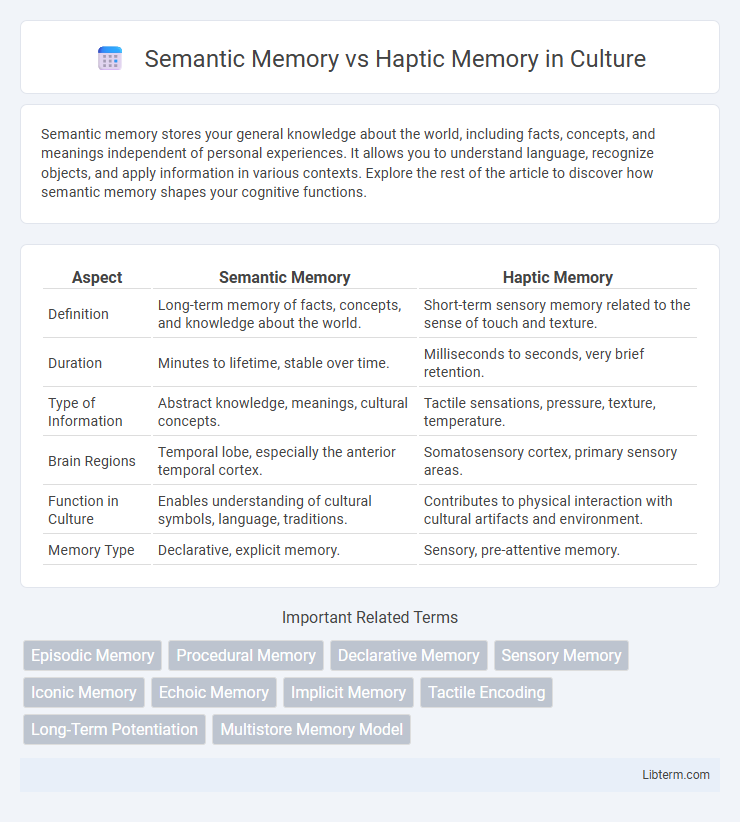Semantic memory stores your general knowledge about the world, including facts, concepts, and meanings independent of personal experiences. It allows you to understand language, recognize objects, and apply information in various contexts. Explore the rest of the article to discover how semantic memory shapes your cognitive functions.
Table of Comparison
| Aspect | Semantic Memory | Haptic Memory |
|---|---|---|
| Definition | Long-term memory of facts, concepts, and knowledge about the world. | Short-term sensory memory related to the sense of touch and texture. |
| Duration | Minutes to lifetime, stable over time. | Milliseconds to seconds, very brief retention. |
| Type of Information | Abstract knowledge, meanings, cultural concepts. | Tactile sensations, pressure, texture, temperature. |
| Brain Regions | Temporal lobe, especially the anterior temporal cortex. | Somatosensory cortex, primary sensory areas. |
| Function in Culture | Enables understanding of cultural symbols, language, traditions. | Contributes to physical interaction with cultural artifacts and environment. |
| Memory Type | Declarative, explicit memory. | Sensory, pre-attentive memory. |
Introduction to Semantic and Haptic Memory
Semantic memory stores general world knowledge, facts, and concepts independent of personal experiences, enabling individuals to understand language, recognize objects, and apply learned information. Haptic memory pertains to the brief sensory storage of tactile stimuli, capturing touch-related details for a fraction of a second to facilitate immediate processing and perception. These distinct memory types support different cognitive functions, with semantic memory underpinning long-term understanding and haptic memory providing momentary touch-based information retention.
Defining Semantic Memory
Semantic memory is a type of long-term memory responsible for storing general world knowledge, facts, concepts, and meanings without reference to personal experiences. It contrasts with haptic memory, which involves the short-term sensory memory related to touch and physical sensations. Understanding semantic memory facilitates improved cognitive functions such as language comprehension, reasoning, and knowledge retrieval.
Understanding Haptic Memory
Haptic memory, a subcomponent of sensory memory, retains tactile information for a brief period, allowing the brain to process and interpret touch stimuli accurately. Unlike semantic memory, which stores general knowledge and facts, haptic memory is crucial for immediate recognition of textures, shapes, and spatial properties through touch. Understanding haptic memory enhances the study of sensory processing and its role in motor skills, object manipulation, and environmental interaction.
Neural Mechanisms Behind Semantic Memory
Semantic memory relies on the medial temporal lobe, prefrontal cortex, and lateral temporal cortex to store and retrieve conceptual knowledge about facts and meanings. Neural mechanisms involve the hippocampus for encoding and the anterior temporal lobes for integrating semantic information across modalities. In contrast, haptic memory primarily engages the somatosensory cortex and parietal regions to process tactile sensory information without the extensive neural networks required for semantic knowledge.
Neural Basis of Haptic Memory
Haptic memory, a type of sensory memory, relies on somatosensory cortex regions, including the primary and secondary somatosensory cortices, which process tactile and proprioceptive information. Neural substrates such as the posterior parietal cortex contribute to the temporary storage and integration of haptic stimuli, enabling recognition and manipulation of objects through touch. This contrasts with semantic memory, primarily mediated by the medial temporal lobe and neocortex, responsible for storing factual and conceptual knowledge.
Key Differences: Semantic vs Haptic Memory
Semantic memory stores general knowledge and facts about the world, enabling understanding of concepts and meanings, while haptic memory involves the sensory retention of touch stimuli, capturing tactile information for a brief period. Semantic memory is long-term and language-based, supporting cognitive functions like reasoning and learning, whereas haptic memory is a form of sensory memory that lasts only seconds and aids in immediate perception of texture, pressure, and shape. The key difference lies in their function and duration: semantic memory processes abstract information and is durable, while haptic memory processes direct tactile sensations and is transient.
Real-Life Examples of Semantic and Haptic Memory
Semantic memory enables recalling factual knowledge such as recognizing that Paris is the capital of France or understanding the meaning of words during a conversation. Haptic memory involves the brief sensory experience of touch, like feeling the texture of a fabric when shopping or sensing the warmth of a mug in your hand. Real-life situations demonstrate semantic memory when retrieving information about historical dates, while haptic memory operates instantly when grasping objects or detecting surface roughness.
Roles in Learning and Everyday Life
Semantic memory stores factual knowledge and concepts essential for language comprehension, problem-solving, and decision-making in daily activities. Haptic memory processes tactile information, enabling the recognition of textures and objects by touch, which is crucial for tasks requiring fine motor skills and spatial awareness. Together, these memory types support comprehensive learning by integrating abstract knowledge with sensory experiences.
Implications for Cognitive Disorders
Semantic memory, responsible for storing general knowledge and facts, often deteriorates in cognitive disorders like Alzheimer's disease, leading to difficulties in language comprehension and information retrieval. Haptic memory, a form of sensory memory associated with touch, tends to remain relatively preserved in early stages of such disorders, offering potential avenues for therapeutic interventions through tactile-based stimulation. Understanding the differential impact on these memory types aids in developing targeted cognitive rehabilitation strategies that leverage intact sensory modalities to support impaired semantic processing.
Future Research Directions in Memory Studies
Future research in memory studies should explore the neural mechanisms differentiating semantic memory, which stores general knowledge and facts, from haptic memory, responsible for short-term tactile information retention. Advances in neuroimaging and machine learning can enhance understanding of how these memory systems interact and their roles in multisensory integration. Investigating the impact of aging and neurodegenerative diseases on semantic and haptic memory can guide the development of targeted cognitive interventions and rehabilitation techniques.
Semantic Memory Infographic

 libterm.com
libterm.com